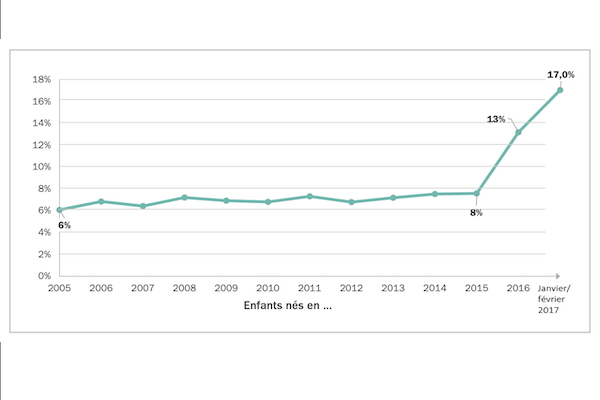 Rate of use of parental leave for (eligible) fathers residing in Luxembourg within twelve months of the birth of the child, based on the year of birth of the child;
Credit: LISER
Rate of use of parental leave for (eligible) fathers residing in Luxembourg within twelve months of the birth of the child, based on the year of birth of the child;
Credit: LISER
On Friday 28 March 2025, the Luxembourg Institute of Socio-Economic Research (LISER) published an analysis of the impact of the parental leave reform which came into effect in Luxembourg in 2016.
As reported by LISER, parental leave is a key policy measure for balancing family and professional life, with its effectiveness depending significantly on its ability to be used fairly by both mothers and fathers. LISER noted that, historically, women have always been the primary users of parental leave, while men have remained less engaged. By facilitating access to parental leave and introducing better financial compensation, the Luxembourgish reform explicitly aimed to increase fathers’ participation.
In its research, LISER used administrative data from the General Inspectorate of Social Security (IGSS) to assess the actual impact of this reform on parental behaviour, particularly among fathers. It summarised the following points:
- the reform notably relaxed access conditions, allowing, for example, the combination of employment with parental leave and extending the period of eligibility until the child reaches six years old, while also diversifying leave options. Additionally, the fixed allowance was replaced by income-related compensation. These adjustments made parental leave more attractive, particularly for fathers;
- research based on social security data (2004-2017) shows that the number of Luxembourgish fathers taking parental leave doubled, from 8% before 2016 to 17% after the reform. Among cross-border workers, the increases were also significant (up to 24.1% for German fathers);
- the impact was particularly strong among new (first-time) fathers, with an average increase of 20%, reaching 27% in middle-income groups and 23% among those with lower incomes. Fathers working in small businesses and those whose partners had greater financial capacity also made greater use of this new parental leave scheme;
- beyond assessing the effectiveness of a public policy, this research helps to better understand how different social groups use work-life balance measures following a reform. It highlights persistent inequalities based on income, professional sector or family structure, thereby contributing to the debate on social justice and the inclusivity of family policies;
- while the progress is encouraging, researchers have called for continued long-term analysis (up to the child’s sixth birthday) to better understand the lasting effects of the reform and identify any persistent inequalities among different social and professional groups.
In conclusion, LISER stated: "Thanks to fairer financial compensation and more flexible access conditions, the reform has removed several barriers, particularly for first-time fathers with modest incomes or those working in small businesses. This development promotes more equitable parenting and reignites the debate on social justice in family policies."
SM








